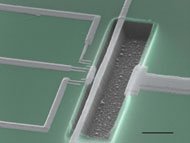Quantum Kicks Quiet Quivering

By Aussiegirl
This article describes the same experiment as the one posted right below, and by reading both, the physics involved seems a bit clearer, although still mind-boggling.
The illustration is of the device used in this experiment, and is described thus:
The gray sliver reaching from top to bottom, slanted in the image, is a nanomechanical resonator, a sub-microscopic device that can vibrate like a piano string. The image was taken with a scanning electron microscope and colorized. Electrons flowing through the adjacent patch of superconductor draw energy from a tiny vibrating beam, reducing its motion.
Quantum Kicks Quiet Quivering -- Cho 2006 (914): 2 -- ScienceNOW
Quantum Kicks Quiet Quivering
By Adrian Cho
ScienceNOW Daily News
14 September 2006
According to quantum mechanics, it's impossible to measure the condition of a tiny object without disturbing it. This kick effectively limits what can be known about the thing and ordinarily keeps it from settling down. Now physicists have turned this unavoidable disturbance to their own advantage and used it, paradoxically, to calm a tiny vibrating beam.
Even the simplest quantum machines could lead to new information technologies and other advances. Researchers are experimenting with tiny beams, or "nanomechanical resonators," that vibrate like nanometer-sized guitar strings. If cooled to near absolute zero, these beams should behave quantum mechanically. Once that happens, researchers hope to then put a beam into a bizarre quantum state in which it literally bows in both directions at once. Such a beam could serve as a quantum bit of information that can encode 0 and 1 at the same time. No one has been able to cool a beam to the required few thousandths of a kelvin, however.
Now, Akshay Naik of the University of Maryland, College Park, Keith Schwab of Cornell University, and colleagues have found a new way to cool a resonator. The researchers first had to track the position of their beam with a superconducting single-electron transistor (SSET), which consists of a tiny patch of superconducting metal lying parallel to the beam. Electrons hopped onto the patch from one end and hopped off at the other. The team applied a voltage between the beam and the patch, which caused any movement of the beam to change the rate at which the electrons flowed through the SSET, allowing the researchers to track the beam's motion.
Ordinarily, the hopping electrons would also jostle the beam by changing the electric charge of the patch and hence the force between patch and beam. But Schwab and colleagues found they could tune another voltage applied to the patch so that the electrons didn't have quite enough energy to jump onto it. In that case, the electrons siphoned a little energy from the beam's motion to help themselves along, a bit like borrowing a nickel to help pay for a $1 subway ride. The energy transfer slowed the beam and cooled it from about 550 millikelvin to 300 millikelvin, the researchers report this week in Nature.
"This is a significant achievement," says Konrad Lehnert, a physicist at JILA, a laboratory run by the National Institute of Standards and Technology and the University of Colorado, Boulder. "Single-electron transistor experiments, they're hard." Robert Knobel, a physicist at Queen's University in Kingston, Canada, says physicists "might be able to use this as a tool to cool the resonator to where we might see quantum mechanics in a macroscopic device."


0 Comments:
Post a Comment
<< Home